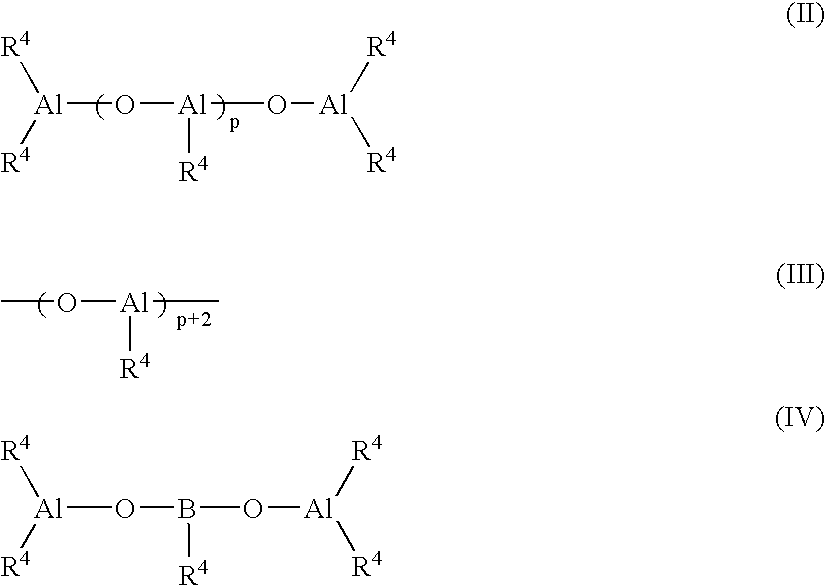Polypropylene type aqueous dispersion, polypropylene type composite aqueous emulsion composition and its use
a technology of polypropylene and aqueous emulsion, applied in the direction of adhesive types, graft polymer adhesives, coatings, etc., can solve the problems of poor adhesion to paint or other resins, degraded working environment during production and use, and inability to achieve satisfactory dispersion stability endurable for practical us
- Summary
- Abstract
- Description
- Claims
- Application Information
AI Technical Summary
Benefits of technology
Problems solved by technology
Method used
Image
Examples
example 1
1. Preparation of Polypropylene
Preparation Example 1
(1) Preparation of dichloro[dimethylsilylene(cyclopentadienyl)(2,4-dimethyl-4H-1-azulenyl)]hafnium
(1)-1 Preparation of Ligand
[0251] After dissolving 2-methylazulene (4.01 g) in tetrahydrofuran (56 ml) and cooling in an ice bath at 0° C., 24.8 ml of a diethyl ether solution of methyl lithium (1.14 mol / l) was dropwise added thereto at the same temperature. After finishing the dropwise addition, the ice bath was taken out, and the resultant mixture was stirred for 2 hours. This solution was slowly dropwise added to a tetrahydrofuran solution (140 ml) of dimethylsilyl dichloride (34.0 ml, 0.280 mol) cooled to 0° C. by an ice bath. After finishing the dropwise addition, the ice bath was taken out, and the resultant mixture was stirred for 3 hours, and the solvent and unreacted dimethylsilyl dichloride were distilled off under a reduced pressure. Thereafter, tetrahydrofuran (80 ml) was added thereto, and the mixture was cooled to 0...
example 2
[0268] 300 g of polypropylene prepared in the above Preparation Example 1, 100 g of maleic anhydride and 900 g of chlorobenzene were placed in a glass flask equipped with a thermometer, a cooling tube, a stirrer and a dropping funnel, and it was dissolved in a nitrogen atmosphere by raising a temperature in the system to 130° C. Thereafter, a solution having 25 g of dicumyl peroxide dissolved in 300 g of chlorobenzene was dropwise added thereto at the same temperature for 5 hours, and aging reaction was carried out for 3 hours. After finishing the reaction, the reaction liquid was cooled to room temperature and was charged into 4.5 kg of acetone to precipitate a maleic anhydride-modified polypropylene which was then separated by filtration. The modified resin was introduced again into 4.5 kg of acetone to be purified, and was separated by filtration and was dried under vacuum. A white powder-like modified resin thus obtained was subjected to infrared ray absorption spectrum measurem...
example 3
1. Preparation of Polypropylene
Preparation Example 2
(1) Chemical Treatment of Clay Mineral
[0271] Desalted water (72 ml), lithium sulfate·1 hydrate (11.1 g) and sulfuric acid (17.1 g) were placed in a 1,000 ml round flask, and the content was dissolved under stirring. Commercially available granulated montmorillonite (Benclay SL manufactured by Mizusawa Industrial Chemicals, Ltd., 16.7 g) was dispersed in this solution, and the mixture was heated to 100° C. over 2 hours and was stirred at 100° C. for 5 hours. Thereafter, the mixture was cooled to room temperature over 1 hour, and a slurry obtained was filtrated to recover a wet cake. The cake thus recovered was slurried again with desalted water (500 ml) in a 1,000 ml round flask, and was filtrated. This operation was repeated twice. The cake finally obtained was dried under a reduced pressure at 200° C. for 1 hour to obtain chemically treated montmorillonite (15.0 g).
(2) Polymerization
[0272] To the chemically treated montmor...
PUM
| Property | Measurement | Unit |
|---|---|---|
| Fraction | aaaaa | aaaaa |
| Fraction | aaaaa | aaaaa |
| Fraction | aaaaa | aaaaa |
Abstract
Description
Claims
Application Information
 Login to View More
Login to View More - R&D
- Intellectual Property
- Life Sciences
- Materials
- Tech Scout
- Unparalleled Data Quality
- Higher Quality Content
- 60% Fewer Hallucinations
Browse by: Latest US Patents, China's latest patents, Technical Efficacy Thesaurus, Application Domain, Technology Topic, Popular Technical Reports.
© 2025 PatSnap. All rights reserved.Legal|Privacy policy|Modern Slavery Act Transparency Statement|Sitemap|About US| Contact US: help@patsnap.com

